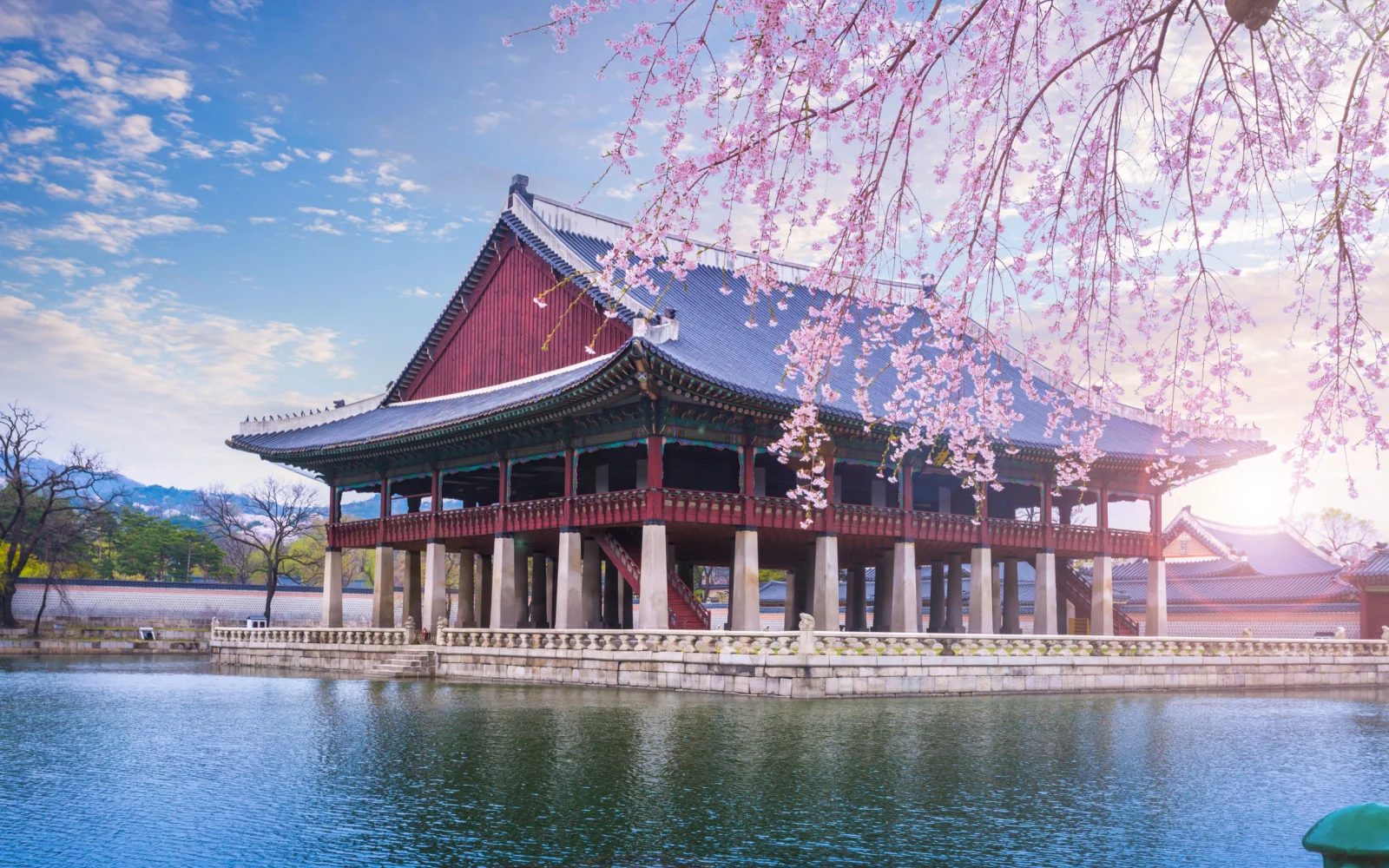What's an average trip to Korea cost?
The average cost for a one-week trip to Korea for two people is approximately $4,900. This includes around $100 per night for accommodation, $1,300 per person for flights, $100 per person per day for food, drink, and activities, and $200 in total for transportation.
It’s safe to say that good things come from Korea. K-pop has swept the globe, while K-dramas rank ever more highly on streaming services, and K-beauty sales are through the roof.
But while we enjoy the lovely exports of South Korea – the only part of Korea with which the rest of the world has contact – there’s nothing like the real thing.
In a country the size of the state of Indiana, it hosts a population of more than 50 million – larger than that of any single state in America. The density of people has led to an amazing diversity of art, culture, history, and architecture.
The wide range of … well, everything … that you’ll find in Korea means that you can visit there without spending a lot of money, because there exists such a wealth of choices.
From hotels to meals, tours to walks, you can find exactly what you’re looking for at price points from dead affordable to pretty pricey. It’s a true Choose Your Own Adventure Abroad!
That’s probably why Korea is such a popular tourist destination. After a sharp decline in 2020 (three guesses why), it is on the rebound and tourism is once again skyrocketing. The perfect destination for couples, families, and solo travelers, it’s time you considered Korea.
You’ll always have to budget, of course, which is why we’re here. Read on!
Average Trip to Korea Cost in 2025
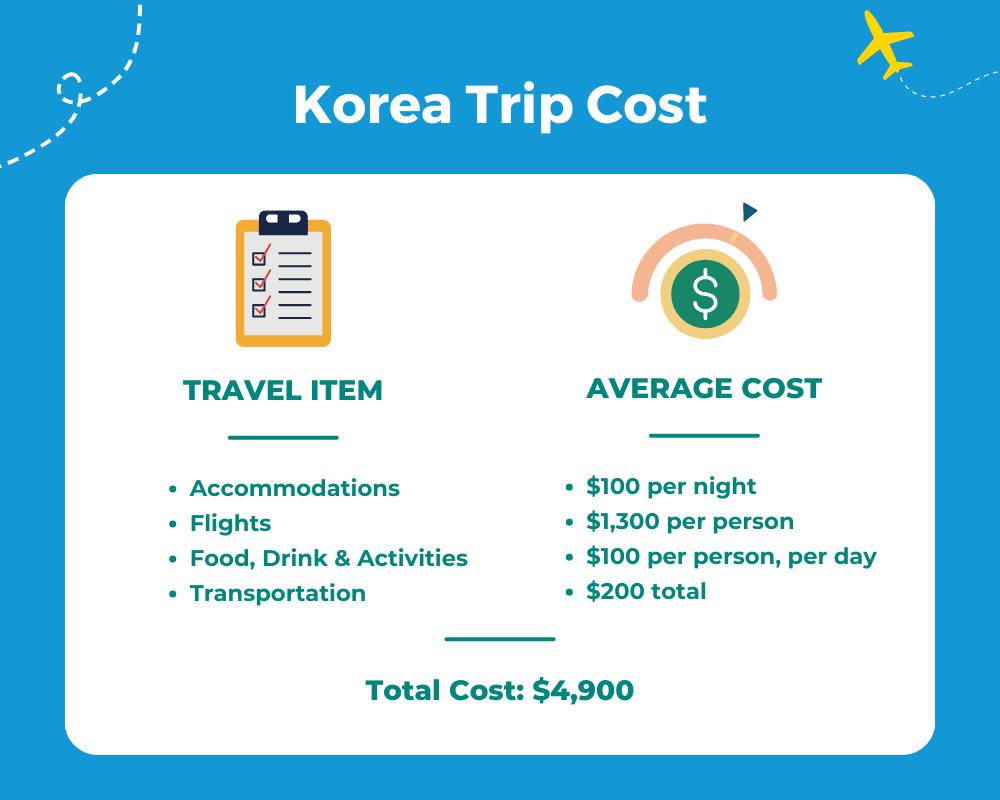
An average one-week trip to Korea for two people will cost around $4,900:
- Average Accommodation Cost: $100 per night
- Average Flight Cost: $1,300 per person
- Food, Drink & Activities: $100 per person, per day
- Transportation: $200 total
- Total Cost: $4,900
South Korea – often simply known as “Korea,” which does not refer equally to its protectionist cousin North Korea – is a surprisingly affordable vacation.
Anyone who has wanted to experience the beauty, charm, and mysticism of the Orient will find everything they’re looking for here in Korea. Even better, the country is very affordable.
Once you pay to get there – the biggest expense of the trip for most people – you will find that the accommodations, food, and activities are all quite reasonable.
Korea Trip Cost: Average by Item
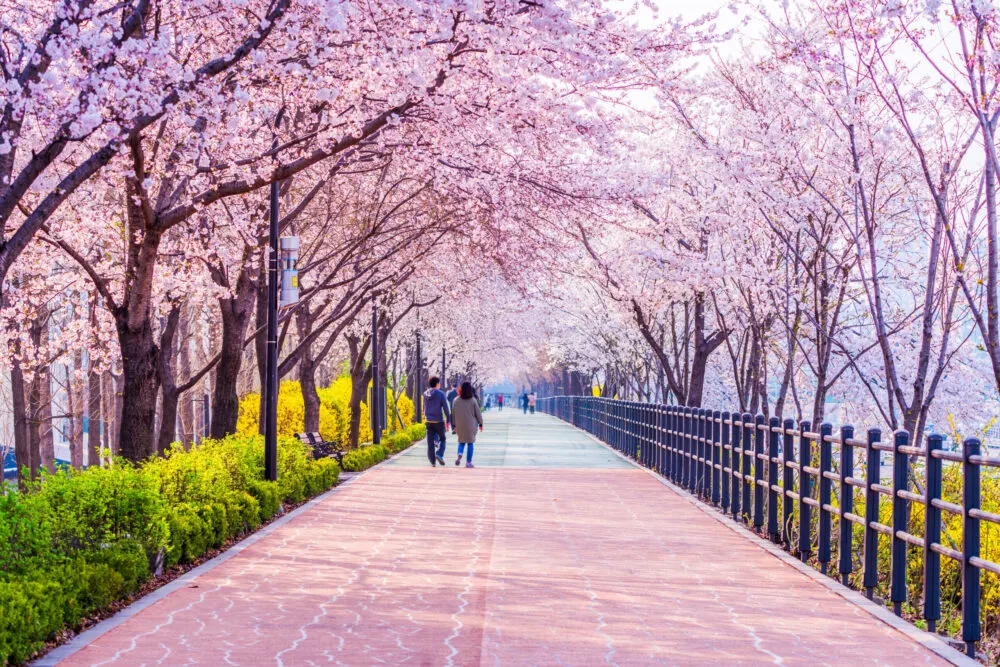
Cherry blossom of Spring in Seoul, South Korea ./CJ Nattanai/Shutterstock
As stated above, South Korea’s incredible diversity makes it possible to find every service you’re looking for at a range of prices.
That said, your trip’s total cost will ultimately depend on when you go, where you go, how many people you travel with, how you eat, and your idea of a good time.
The sections below will consider average prices, then offer you some of the best ways to save on your adventure!
Accommodation Costs
Hotels are as much or as little as you want them to be in Korea. If you’re looking for a luxury 4- or 5-star experience in Seoul, you’ll pay around $200 per night.
There are always deals, however: honeymooners should check out the Lotte Hotel Seoul, which has rooms for less than $180 a night with all the 5-star amenities a person could wish for.
Mostly, hotels will range between $50 and $150 in the big cities. A guesthouse room in a charming “hanok” village, composed of the traditional homes that bear that name, will run you about $125, on average, though you can find cheaper rooms.
Overall, if you’re planning a budget vacation, give yourself $100 a night and make sure to book your accommodations ahead of time, when there’s still plenty of availability.
Flight Costs
Korea is a full travel day away from most places in the US, and as such, tickets there are not cheap. From Los Angeles, you’re looking at around $1,100 to $1,200 on average. Add a few hundred dollars if you’re flying out of Chicago, New York City, or a non-hub.
Overall, plan to spend about $1,300 per person, assuming you book well in advance.
Happily, there are a few ways to cut down costs. For one, you can save money on international flights by booking further in advance (see our guide on “how far in advance should you book a flight?).
This is actually a good trick when price shopping for anything. Note that South Korea is a Northern Hemisphere country, which means that it experiences winter at the same time the United States does.
It’s not a warm Northern Hemisphere country, either … January’s temps routinely dip below 20 degrees Fahrenheit, with December and February close behind.
All of which is to say, tourism dips significantly during the colder months, and prices along with them. If you like to get out of dodge during the winter and don’t mind bringing your snow gear with you, Korea is an excellent place to go.
You can save hundreds of dollars per person on airfare and hotels if you price shop, while still having a great time in a winter wonderland. With skiing, snowshoeing, sledding, and hiking, you won’t be bored!
You might see a spike in prices around Christmas, FYI, since many Koreans celebrate it. However, if you want to enjoy some holiday magic, you won’t be disappointed!
Pro Tip: Always search in incognito mode. When you do this, your browser can’t save cookies from the flights you check, so the web doesn’t “know” you’re interested in flights and can’t jack up the prices for your next visit.
Food, Drink & Activity Costs
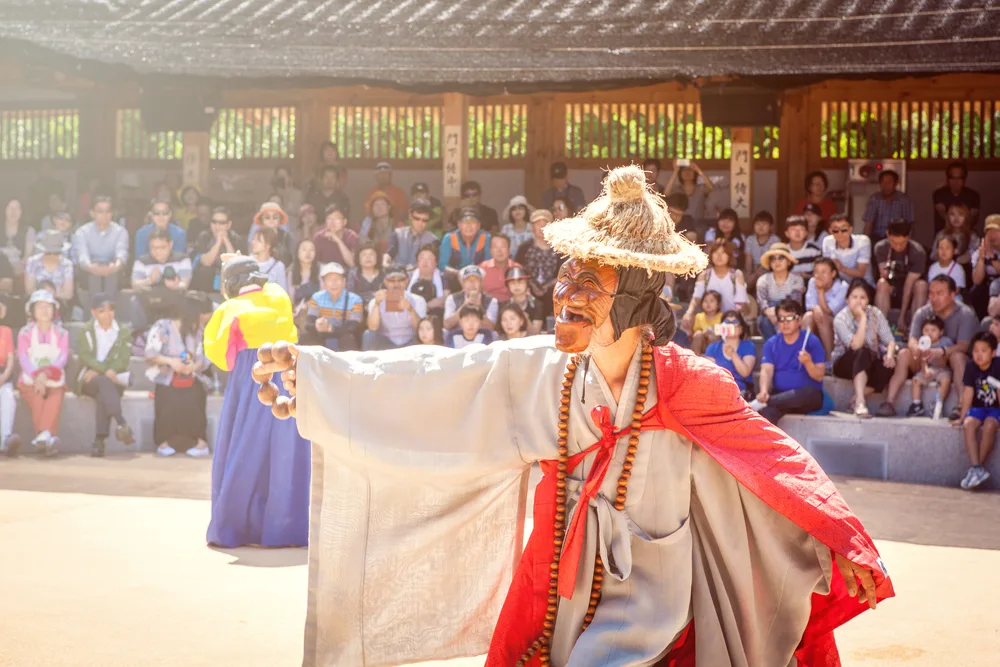
andong hahoe village, in repulbic korea, june 11, 2017, people are performiing korean traditional mask dance/NothingIsEverything/Shutterstock
Food and drink won’t cost you that much in South Korea unless you really make an effort to go out for nice meals. You can find a delicious lunch or dinner for around $10 if you pop into the many noodle, barbecue, or other restaurants in the cities and villages.
Grocery stores and delis are also great places to experience the best the local cuisine has to offer. With continental breakfasts available at many hotels, you can get by on about $30 a day for food, assuming you’re not buying drinks out.
If you are, budget more accordingly.
Korea is incredibly rich in cultural heritage. For instance, many visitors enjoy a trip to the historic villages of Hahoe and Yangdong, two of the most shining examples of medieval Korean architecture and lifestyle.
“Founded in the 14th-15th centuries, Hahoe and Yangdong are seen as the two most representative historic clan villages in the Republic of Korea,” says UNESCO.
“Their layout and location – sheltered by forested mountains and facing out onto a river and open agricultural fields – reflect the distinctive aristocratic Confucian culture of the early part of the Joseon Dynasty (1392-1910).”
These villages give you a glimpse into what life was like back then, with architecture that includes “residences of the head families, together with substantial timber framed houses of other clan members, also pavilions, study halls, Confucian academies for learning, and clusters of one story mud-walled, thatched-roofed houses, formerly for commoners.”
It’s a day trip well worth the travel time and will cost you about $150 per person from Seoul, on average.
Tours of the DMZ (demilitarized zone) and suspension bridge, the royal palace, or Nami Island will all cost you about $100, though you may be able to bargain the price down if you book a private tour with your own group. Between tours and food, budget about $100 a day per person.
Transportation Costs
Transportation is very affordable in Korea. Public buses cost about a dollar anywhere in Seoul, while its subway system is fast, efficient, and cheap as well.
A train ticket to Busan – about 3 hours away – will cost you about $35. An in-town taxi will rarely cost you more than $5 or $10, making it another affordable way to travel.
Overall, assuming you do the bulk of your long-distance journeying with tours, you can safely budget $200 for transportation for a couple.
Things to Consider
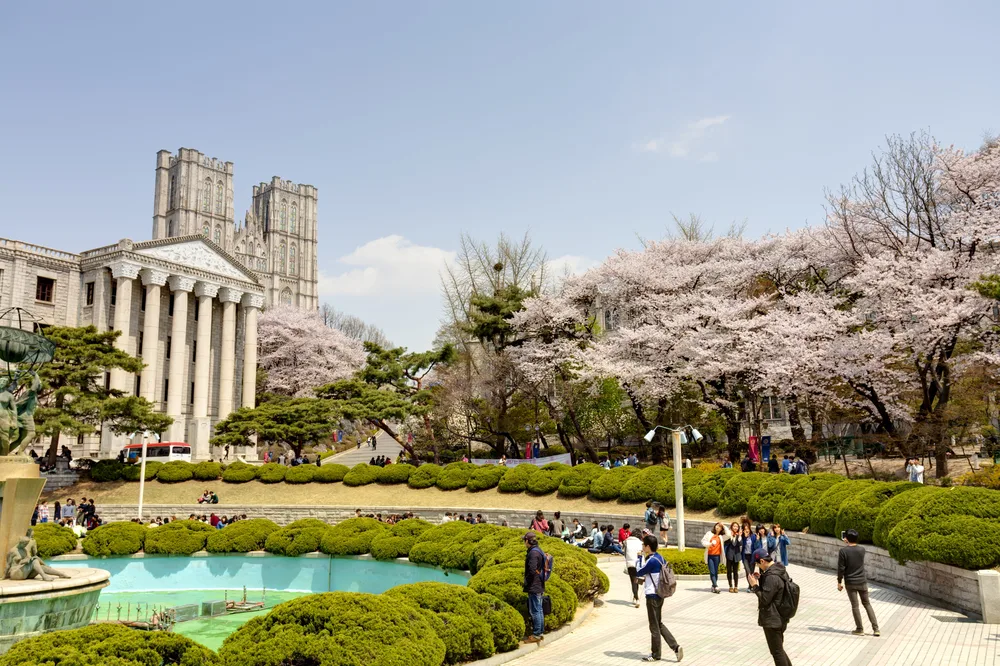
SEOUL, KOREA-APRIL 18: Students are walking and taking pictures at the campus street which is lined with cherry trees of full blossoms in Kyung Hee University on April 18, 2013 in Seoul, Korea./qingqing/Shutterstock
Here are a few other things to consider when planning your trip to Korea:
- Ditch Google Translate for Naver Papago. This translation app was developed in Korea, so while it’s not necessarily more reliable than gold-standard Google for other countries and languages, it’s a dead cert when visiting Korea. Keep it handy to talk with shop owners, restaurateurs, guides, taxi drivers, airport personnel, and more.
- Korean universities are gorgeous, and they’re a great free activity too! Their architecture and layout rival American Ivy League campuses, and you can spend hours walking around or checking out the museums and gardens. Happily, there are dozens in Seoul alone. Daegu, Iksan, and Chungcheongbuk-do all have one worth visiting as well.
- Beware of micro-dust. Studies have shown that air pollution (much of it traveling from China’s factories) can hang heavily in Seoul and other parts of South Korea, especially particulate matter. Bring a good mask in case air quality is bad one day you’re there, and consider traveling in the fall, when it tends to be better.
- Don’t rely on Google Maps, which doesn’t work reliably in Korea. Instead, download and use Naver Map, which is not only dependable for directions but can help you track the hours of establishments, which may change without notice.
- Consider a DMZ tour. North Korea is a mystery to most foreigners and is likely to remain so for years to come. However, you can get a thorough background on this bizarre situation by taking a tour of the demilitarized zone for between $50 and $100 per person.
Frequently Asked Questions

Jeju Island, South Korea – July 10, 2022: Stairs to climb Seongsan mountain in Jeju Island, South Korea./PangJee_S/Shutterstock
Do I need a visa to visit Korea?
No, you don’t need a visa to go to South Korea. All you need is a passport with a blank page for a stamp (it will need its own page) and current validity. South Korea does not even require that your passport be valid for a specific amount of time after entry.
When is the best time to visit Korea?
The best time to visit Korea depends on your priorities. If you want to save money, then the best months to travel are the colder ones – October through March will all net you better prices on flights, hotels, and tours. Plus, you’ll avoid the big crowds that arrive in the spring, summer, and fall. If you make it by mid-October, you’ll also enjoy some spectacular fall displays.
If, on the other hand, you’re headed to Korea for sunny weather, outdoor dining, and beach-going, then shoot for late spring through early fall. You’ll pay more for the privilege, but it’s worth it for the experience.
Is Korea expensive?
Korea is not particularly expensive, which is why many people choose to bring their families there. If you use the above money-saving hacks, you can go to Korea for less than some people pay to go to Disney World.
Is it safe in Korea?
It’s quite safe in Korea. However, every American should sign up for the Smart Traveler Enrollment Program (STEP) before traveling abroad. It is a “free service to allow U.S. citizens and nationals traveling and living abroad to enroll their trip with the nearest U.S. Embassy or Consulate” as well as “Receive important information from the Embassy about safety conditions in your destination country, helping you make informed decisions about your travel plans.”
Best of all, STEP will “Help the U.S. Embassy contact you in an emergency, whether natural disaster, civil unrest, or family emergency.”
Where should I go?
Anyone visiting Korea should make Seoul their first stop. Not only is it an easy place to visit because most tourists land there on arrival, it has a stunning wealth of art, cinema, architecture, shopping, gardens, universities, and cultural destinations.
After that, the best places to visit include Jeju Island and Uleung Island for ocean beauty, the DMZ for modern history, Dadohaehaesang National Park and Pyeongchang County for amazing hiking, Boseong Green Tea Field and Sunrise Peak for photogenic scenery, and any temple you can get your hands on.
So, What Is the Average Cost of a Trip to Korea?
| 🛎️ Average Accommodation Cost | $100 per night |
| ✈️ Average Flight Cost | $1,300 per person |
| 🍽️ Food, Drink & Activities | $100 per person, per day |
| 🚕 Transportation | $200 total |
| 💲 Total Cost | $4,900 |
The average cost of a one-week trip to Korea is around $4,900 for two people. For the privilege of seeing a magical Eastern country, with all the wonderful heritage, food, and adventure that comes with it, this is a pretty good deal!



